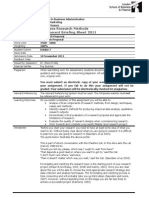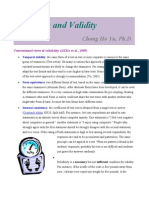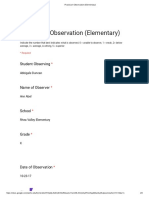0 ratings0% found this document useful (0 votes)
162 viewsAction Research Poster
Action Research Poster
Uploaded by
api-384464451This study examined how assigning seats impacts student grades in a 6th grade math class. Two classes were selected - a control group that sat wherever they wanted and an experimental group with assigned seats. Both groups had a similar distribution of academic levels. The study collected assessment scores from both groups over five tests and compared the average scores to see if assigned seating increased or decreased grades. Previous research found that assigned seating can improve learning by increasing teacher-student interactions, but the optimal arrangement depends on the task. The study aimed to help teachers decide whether to implement assigned seating.
Copyright:
© All Rights Reserved
Available Formats
Download as PDF, TXT or read online from Scribd
Action Research Poster
Action Research Poster
Uploaded by
api-3844644510 ratings0% found this document useful (0 votes)
162 views1 pageThis study examined how assigning seats impacts student grades in a 6th grade math class. Two classes were selected - a control group that sat wherever they wanted and an experimental group with assigned seats. Both groups had a similar distribution of academic levels. The study collected assessment scores from both groups over five tests and compared the average scores to see if assigned seating increased or decreased grades. Previous research found that assigned seating can improve learning by increasing teacher-student interactions, but the optimal arrangement depends on the task. The study aimed to help teachers decide whether to implement assigned seating.
Original Title
action research poster
Copyright
© © All Rights Reserved
Available Formats
PDF, TXT or read online from Scribd
Share this document
Did you find this document useful?
Is this content inappropriate?
This study examined how assigning seats impacts student grades in a 6th grade math class. Two classes were selected - a control group that sat wherever they wanted and an experimental group with assigned seats. Both groups had a similar distribution of academic levels. The study collected assessment scores from both groups over five tests and compared the average scores to see if assigned seating increased or decreased grades. Previous research found that assigned seating can improve learning by increasing teacher-student interactions, but the optimal arrangement depends on the task. The study aimed to help teachers decide whether to implement assigned seating.
Copyright:
© All Rights Reserved
Available Formats
Download as PDF, TXT or read online from Scribd
Download as pdf or txt
0 ratings0% found this document useful (0 votes)
162 views1 pageAction Research Poster
Action Research Poster
Uploaded by
api-384464451This study examined how assigning seats impacts student grades in a 6th grade math class. Two classes were selected - a control group that sat wherever they wanted and an experimental group with assigned seats. Both groups had a similar distribution of academic levels. The study collected assessment scores from both groups over five tests and compared the average scores to see if assigned seating increased or decreased grades. Previous research found that assigned seating can improve learning by increasing teacher-student interactions, but the optimal arrangement depends on the task. The study aimed to help teachers decide whether to implement assigned seating.
Copyright:
© All Rights Reserved
Available Formats
Download as PDF, TXT or read online from Scribd
Download as pdf or txt
You are on page 1of 1
Graduate Action Research Project
Emory & Henry College
Fall 2017
Abbigale Duncan
Introduction / Rationale Research Topic Literature Review
Introduction / Rationale
v The purpose of this study was to How are students’ grades impacted v “Seating arrangements in rows
identify how students’ grades are may be chosen to improve
impacted when assigned seating when assigned seating is information dissemination,
is implemented into a implemented into a mathematics- whereas an arrangement in
mathematics-learning learning environment? small groups may be chosen to
environment. The study will focus promote student interactions.”
on whether or not students’ (Gremmen, Van Den Berg,
achievement is increased when a Research Design Segers, & Cillessen, p. 753)
teacher implements an assigned
seating chart in their classroom. v For this study, two classes of sixth grade v According to Roy (2012), with
mathematics students were selected. the changing needs of our
v After two semesters of students, there cannot be one
implementing both of the v The control group, those who sat wherever they ideal arrangement for a single
strategies, student achievement would like in class, consisted of 20 students. Of classroom.
was compared between the two these 20 students, academically speaking, 7 are
classes. This study can assist above level, 10 are on level, and 3 are below v “A student’s location in the
teachers when making decisions level. classroom is related to the
about assigned seating number of questions received
arrangements in their v The experimental group, those who have from the teacher; this may
classrooms. assigned seats implemented by the teacher, influence the student’s
consisted of 20 students. Of these 20 students, opportunity to respond and thus
academically speaking, 7 are above level, 9 are learn.” (Wannarka & Ruhl, p. 89)
on level, and 4 are below level.
v “Results indicate that teachers
v Academic data of both groups was collected should let the nature of the task
using five different assessments. dictate seating arrangements.”
(Wannarka & Ruhl, p. 89)
v The assessment averages between the five
assessments was compared to find an increase
or decrease in scores.
You might also like
- Facs Lie To Me Paul EkmanDocument181 pagesFacs Lie To Me Paul EkmanLucasEliasNo ratings yet
- Essentials of Polymer Science and Engineering by Paul C. Painter & Michael M. Coleman PDFDocument530 pagesEssentials of Polymer Science and Engineering by Paul C. Painter & Michael M. Coleman PDFPrasanna Kumar S Mural86% (7)
- Methods 169 Syllabus Fall 2014Document8 pagesMethods 169 Syllabus Fall 2014buddhaNo ratings yet
- Primary DataDocument7 pagesPrimary Datareneesh100% (7)
- Types of Dissertations and Its DisciplinesDocument2 pagesTypes of Dissertations and Its DisciplinesClarke BensonNo ratings yet
- Stajkovic e Luthans 1998 Self-Efficacy and Work-Related Performance - A Meta-Analysis.Document22 pagesStajkovic e Luthans 1998 Self-Efficacy and Work-Related Performance - A Meta-Analysis.Angela Saraiva Freitas100% (2)
- Experiment ResearchDocument13 pagesExperiment ResearchmazorodzesNo ratings yet
- Communication ProcessDocument18 pagesCommunication ProcessAdilNo ratings yet
- RKSB Pilot Studies 04-25-2018 SBDocument33 pagesRKSB Pilot Studies 04-25-2018 SBFelNo ratings yet
- Important TopicsDocument13 pagesImportant TopicsAnabia ChodryNo ratings yet
- Research Methods in Social ScienceDocument7 pagesResearch Methods in Social ScienceNicholas SiochaNo ratings yet
- Chapter 7 Developing A Conceptual FrameworkDocument8 pagesChapter 7 Developing A Conceptual FrameworkMary Grace Fano TavarroNo ratings yet
- Healt MODELS TheoriesDocument6 pagesHealt MODELS TheoriesDthird Mendoza ClaudioNo ratings yet
- Hypothesis Testing and Errors in Hypothesis: Dr. Abdur RasheedDocument29 pagesHypothesis Testing and Errors in Hypothesis: Dr. Abdur RasheedSafi SheikhNo ratings yet
- Action ResearchDocument12 pagesAction ResearchLee CelNo ratings yet
- 44 Grounded TheoryDocument20 pages44 Grounded TheoryTARUSHI KAURNo ratings yet
- Masters Research Proposal Assignment Intake 7 + 8TUDocument3 pagesMasters Research Proposal Assignment Intake 7 + 8TUsalman_fccNo ratings yet
- Case Study Research.: Design and MethodsDocument9 pagesCase Study Research.: Design and MethodsAkshu GillNo ratings yet
- Boards of Technical Education Pakistan: Statistics DBA - I (Approved Syllabus For ACCA Students)Document2 pagesBoards of Technical Education Pakistan: Statistics DBA - I (Approved Syllabus For ACCA Students)TashfeenNo ratings yet
- Tools of Research (Interview and Observation)Document38 pagesTools of Research (Interview and Observation)Scorpian MouniehNo ratings yet
- 1 s2.0 S2210831912000033 Main PDFDocument8 pages1 s2.0 S2210831912000033 Main PDFlyubovshankarNo ratings yet
- Classroom ResearchDocument99 pagesClassroom ResearchKukuh PramuditoNo ratings yet
- Soal Yang Udah DibikinDocument6 pagesSoal Yang Udah DibikinPanji KasatriaNo ratings yet
- Assignment 2 Research MethodsDocument2 pagesAssignment 2 Research MethodschyralisNo ratings yet
- From Pilot Studies To Confirmatory Studies: Naihua DUANDocument4 pagesFrom Pilot Studies To Confirmatory Studies: Naihua DUANCreativ PinoyNo ratings yet
- ResearchMethodology QuestionnairesDocument16 pagesResearchMethodology QuestionnairesPinkAlertNo ratings yet
- Measures of Validity Report 2Document15 pagesMeasures of Validity Report 2Romeo Madrona JrNo ratings yet
- Data CollectionDocument31 pagesData Collectionvrvasuki100% (2)
- Educational Research PresentationDocument38 pagesEducational Research PresentationZainab WaqasNo ratings yet
- Quantitative and Qualitative Research inDocument15 pagesQuantitative and Qualitative Research inteorb teorb100% (1)
- Public Speaking 1227589720850231 9Document21 pagesPublic Speaking 1227589720850231 9shahrilcangNo ratings yet
- Interactive Lecture StrategiesDocument37 pagesInteractive Lecture StrategiesJiT2U100% (1)
- Types of Sampling Sampling Methods With Examples QuestionProDocument1 pageTypes of Sampling Sampling Methods With Examples QuestionProRanaNo ratings yet
- ParadigmsDocument6 pagesParadigmsReshma GeorgiNo ratings yet
- Analysing Qualitative DataDocument7 pagesAnalysing Qualitative DataDarwiza Figueroa GuimocNo ratings yet
- Purpose of ResearchDocument3 pagesPurpose of ResearchPRINTDESK by DanNo ratings yet
- Research Methods in Education Course SyllabusDocument10 pagesResearch Methods in Education Course SyllabusAbdalla Osman AbdiNo ratings yet
- Tips For Good DissertationDocument28 pagesTips For Good DissertationSada ShivNo ratings yet
- 4 Nature of ResearchDocument32 pages4 Nature of Researchanon_772914876No ratings yet
- QuizDocument13 pagesQuizTokitha Ferguson0% (3)
- Challenges On The Implementation of The 3 - Year Diploma Curriculum in TESDA Region IXDocument7 pagesChallenges On The Implementation of The 3 - Year Diploma Curriculum in TESDA Region IXIOER International Multidisciplinary Research Journal ( IIMRJ)No ratings yet
- Descriptive Statistics Chi SquareDocument8 pagesDescriptive Statistics Chi SquareudayskNo ratings yet
- Literature Review MatrixDocument1 pageLiterature Review MatrixRameez AnwarNo ratings yet
- Difference Between Quantitative and Qualitative Research in The Perspective of The Research ParadigmDocument3 pagesDifference Between Quantitative and Qualitative Research in The Perspective of The Research ParadigmQamar Zaman MalikNo ratings yet
- Action Research - The School As The Center of InquiryDocument47 pagesAction Research - The School As The Center of Inquiryis03lcm100% (1)
- Differences Between Qualitative and Quantative ResearchDocument8 pagesDifferences Between Qualitative and Quantative ResearchLori Perez100% (1)
- What Are We Talking About When We Talk About Impact?Document22 pagesWhat Are We Talking About When We Talk About Impact?impactsp2No ratings yet
- Project Based Learning Essentials ChecklistDocument2 pagesProject Based Learning Essentials Checklistelowman26No ratings yet
- Tating, Marvel E. Bsit - 3E 1. Define The Ff. and Give Examples. Exploratory ResearchDocument7 pagesTating, Marvel E. Bsit - 3E 1. Define The Ff. and Give Examples. Exploratory ResearchMarvel TatingNo ratings yet
- EDU555 Curriculum Evaluation, CIPP ModelDocument20 pagesEDU555 Curriculum Evaluation, CIPP ModelFatin NabilahNo ratings yet
- R McqsDocument34 pagesR Mcqsanam farzandNo ratings yet
- Al-Saadi - Demystifying Ontology and Epistemology in ResearchDocument11 pagesAl-Saadi - Demystifying Ontology and Epistemology in ResearchSujal FoodsNo ratings yet
- Research PhilosophyDocument4 pagesResearch Philosophynad101100% (1)
- Specifying A Purpose and Research Questions or HypothesisDocument9 pagesSpecifying A Purpose and Research Questions or Hypothesisapi-545326560100% (1)
- Data Collection MethodsDocument18 pagesData Collection MethodsachsurajNo ratings yet
- Mixed Methods - PresentationDocument16 pagesMixed Methods - PresentationObote DanielNo ratings yet
- Classroom Observation and ResearchDocument12 pagesClassroom Observation and ResearchVerito Vera100% (1)
- ENGACPROF 5. Research SkillsDocument29 pagesENGACPROF 5. Research SkillsDenise Corpin100% (1)
- Reliability and ValidityDocument14 pagesReliability and ValidityJanine Colindon Dela Vega100% (1)
- Research Strategy A Complete Guide - 2020 EditionFrom EverandResearch Strategy A Complete Guide - 2020 EditionRating: 5 out of 5 stars5/5 (1)
- Final Integrated Unit PlanDocument28 pagesFinal Integrated Unit Planapi-384464451No ratings yet
- Perimeter LessonDocument4 pagesPerimeter Lessonapi-384464451No ratings yet
- Classroom Rules: (Kindergarten)Document1 pageClassroom Rules: (Kindergarten)api-384464451No ratings yet
- Classroom Management MethodsDocument4 pagesClassroom Management Methodsapi-384464451No ratings yet
- Dss CertificateDocument1 pageDss Certificateapi-384464451No ratings yet
- Sol 8Document1 pageSol 8api-384464451No ratings yet
- Scarecrow Oct 2Document1 pageScarecrow Oct 2api-384464451No ratings yet
- Abbigale Duncan 10-23-17Document6 pagesAbbigale Duncan 10-23-17api-384464451No ratings yet
- Smelling LessonDocument1 pageSmelling Lessonapi-384464451No ratings yet
- Aic Lec 01 Introduction v01Document46 pagesAic Lec 01 Introduction v01Ahmed Al-SayedNo ratings yet
- The Impact of Covid-19 On Construction Projects in KuwaitDocument5 pagesThe Impact of Covid-19 On Construction Projects in KuwaitADI LINA MUSTAFFANo ratings yet
- Physics 41 Calorimetry: Determination of Specific Heat Capacity of CopperDocument2 pagesPhysics 41 Calorimetry: Determination of Specific Heat Capacity of CopperAmeva Ameve Sinangote CañosoNo ratings yet
- Politeness in English and Syriac - A Comparative StudyDocument141 pagesPoliteness in English and Syriac - A Comparative StudySalam Neamah HakeemNo ratings yet
- Millard - 1984Document13 pagesMillard - 1984Jackeline SantosNo ratings yet
- Forensic Chemistry ToxicologyDocument60 pagesForensic Chemistry ToxicologyMave RuizNo ratings yet
- Is5312 Week10-V2Document51 pagesIs5312 Week10-V2lengbiao111No ratings yet
- University of Cebu - Main Campus College of Teacher Education Sanciangko Street, Cebu City SECOND SEMESTER 2020-2021 TC Ec 322 - Enhancement Course 2Document4 pagesUniversity of Cebu - Main Campus College of Teacher Education Sanciangko Street, Cebu City SECOND SEMESTER 2020-2021 TC Ec 322 - Enhancement Course 2FatimaNo ratings yet
- 106 指考單字Document2 pages106 指考單字黃紘志No ratings yet
- Reading ReadinessDocument9 pagesReading ReadinessAmerica_Atega_9337No ratings yet
- Lesson 12Document20 pagesLesson 12shrekpoop8No ratings yet
- Essay Keeping Strets CleanDocument2 pagesEssay Keeping Strets CleanLuka KaroianiNo ratings yet
- Machine Learning Vs Statistical Methods For Time SDocument9 pagesMachine Learning Vs Statistical Methods For Time SMaria Aroa del Río DiezNo ratings yet
- (Studies in Continental Thought) O'Byrne, Anne Elizabeth - Natality and Finitude (2010, Indiana University Press) PDFDocument218 pages(Studies in Continental Thought) O'Byrne, Anne Elizabeth - Natality and Finitude (2010, Indiana University Press) PDFGabriel Barrella100% (1)
- Should The School Decide On A Student's Appearance?Document3 pagesShould The School Decide On A Student's Appearance?4crazy TeamNo ratings yet
- Gender Equality Is Very Popular These Days - Express Your Opinion On The Given TopicDocument6 pagesGender Equality Is Very Popular These Days - Express Your Opinion On The Given Topicanand100% (1)
- The Kirtlandian Land-Vertebrate Age-Faunal ComposiDocument25 pagesThe Kirtlandian Land-Vertebrate Age-Faunal ComposiElihu GuzmanNo ratings yet
- Axl Rome P. Flores Bsa - 3B Friedman Test Activity: Trial 3Document3 pagesAxl Rome P. Flores Bsa - 3B Friedman Test Activity: Trial 3Axl Rome FloresNo ratings yet
- CAE Writing Part 1: Formal Essay: Task TypeDocument6 pagesCAE Writing Part 1: Formal Essay: Task TypeToni DuranNo ratings yet
- Figure 8.4-1 Psychrometric chart-SI Units. Reference States: HDocument4 pagesFigure 8.4-1 Psychrometric chart-SI Units. Reference States: HSEBASTIAN ANDRES MARTINEZ GLORIANo ratings yet
- Is Science Trustworthy - Part 1 - The Scientific MethodDocument24 pagesIs Science Trustworthy - Part 1 - The Scientific MethodShivam Kumar MishraNo ratings yet
- Universo de Reposio MobilDocument36 pagesUniverso de Reposio MobilAdrian MartinNo ratings yet
- Ch4 DC Switching Power Supply 2023-11-04Document40 pagesCh4 DC Switching Power Supply 2023-11-04hsiaopeihsuanNo ratings yet
- Third YearDocument30 pagesThird YearLyza MazoNo ratings yet
- Mock Quiz Solution Key PDFDocument20 pagesMock Quiz Solution Key PDFLong Live TauNo ratings yet
- TG-5101 Module Outline and ScheduleDocument2 pagesTG-5101 Module Outline and Scheduledanang januariNo ratings yet
- BANK3011 Workshop Week 5 SolutionsDocument3 pagesBANK3011 Workshop Week 5 SolutionsZahraaNo ratings yet
- Romblon PIR Report 1st Quarter 2023 - EnhancedDocument50 pagesRomblon PIR Report 1st Quarter 2023 - EnhancedJonathan LilangNo ratings yet


































































































